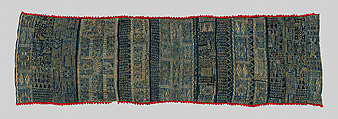Royal display cloth (ndop)
Not on view
This expansive, twenty-seven-foot-long ndop royal display cloth was used to delineate the setting for royal state events and ceremonies. Multiple patches and repairs attest to its extensive use over time. The variety in style and quality of the resist-dyed patterns reflect the collaborative work of several specialists. Both the geometric motifs (circles, lozenges, and meandering lines) and the stylized figurative forms (crocodiles) have royal symbolism. Similarly, the blue color of the cloth refers to the Bamileke elite. Like tsesah crests, ndop cloths are part of the practice of power in the Bamileke region and are tied to long-standing regional exchange networks. Luxury indigo resist-dyed cloths were first imported in the Cameroon Grassfields from the Upper Benue River region of eastern Nigeria. Local production of the cloths began in about 1910. The red wool along the fringe is made from material imported from abroad. Ndop display cloths are still among the favorite gifts exchanged among leaders in the Grassfields.
Due to rights restrictions, this image cannot be enlarged, viewed at full screen, or downloaded.
This artwork is meant to be viewed from right to left. Scroll left to view more.






